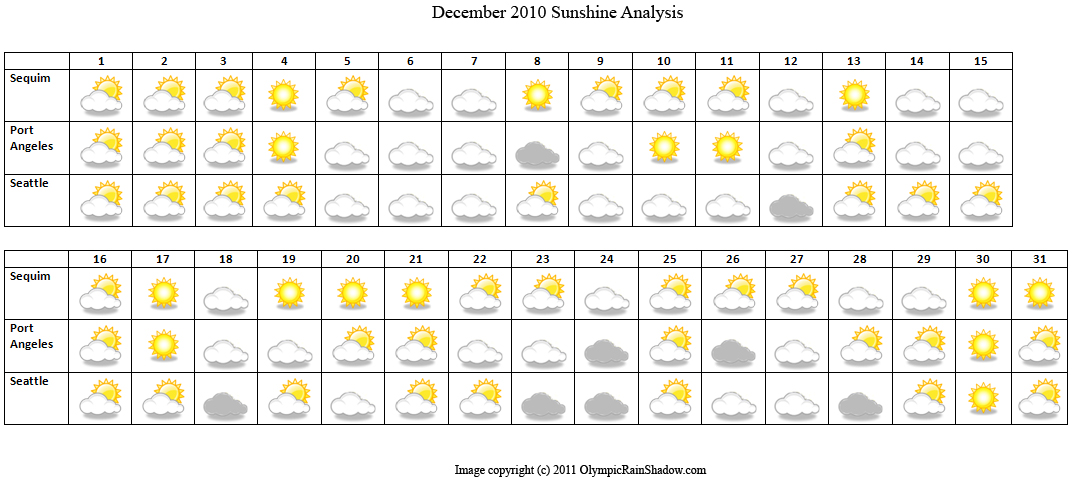
|
Home Page | Map and Climate | Sunshine Studies | Sequim Weather | Sequim Webcam | Activities | About December 2010 Sunshine Analysis – Olympic Rain Shadow vs. Downtown Seattle Our third monthly study examines the month of December, 2010 and sunshine data from three different weather stations, one located in Sequim, one in Port Angeles, and one in Seattle. December is a typically cold, wet, and stormy month. This December saw a very active, stormy weather pattern, with a major Pineapple Express event on the 11th and 12th, with additional stormy periods almost every week during the month. Measured weather was wetter and warmer than normal in greater Seattle, yet the Olympics created quite a shadow! Overall sunny days in Sequim were actually up from 7 in November to 9 in December, while Seattle only recorded 1 sunny day. Overall, Seattle was remarkably dark in December, and Sequim saw 1.36 times the recorded sunlight as Seattle. Once again, Port Angeles also recorded brighter overall weather than Seattle, but was outpaced dramatically by Sequim. Study Highlights:
Detailed Study Findings The Sequim site recorded 9 mostly sunny days, to Seattle's 1 mostly sunny days. Seattle had 5 dreary days, compared to none in Sequim, and 3 in Port Angeles.
On average for the month, the
Sequim site had .98 hours of clear sunny skies per day, where as Seattle had .23
hours. The Port Angeles site recorded .73 hours of clear sunny skies per day on
average. In terms of pure solar radiation, the Sequim site for the month
recorded 1.36 times as much overall solar radiation as Seattle, and 1.20 times as much as the Port Angeles site.
Study Conclusion
Appendix Study Methodology This study was conducted by examining incident solar radiation. Solar radiation is measured in watts per square meter. This measurement is directly related to illuminance, a measure of how much light falls on a given area. We used data from three different weather stations. The first station, the Sequim station, is located on the roof of a single story home on Jamestown Beach Rd, in Sequim, directly on the shores of the Strait of Juan de Fuca. This location may be very close to the epicenter of the Olympic Rain Shadow. As with many locations on the Dungeness plain in Sequim, this one is not shaded by tall trees, nor does it have any hills affecting its exposure. When the sun rises in the morning, it clears the horizon almost immediately as the areas to the south and east are open water. When the sun sets in the evening, it sets to the west, over the Dungeness plain, so stays above the horizon for quite some time. The Sequim location uses a Davis Instruments Vantage Pro 2 with optional solar sensor. This station measures solar radiation every 2 minutes and records the average over 10 minutes. The second station is in downtown Port Angeles, at Lincoln High School. The school's Davis Instruments Vantage Pro2 Plus sensors are mounted on the rooftop of the high school, about a mile southwest of ferry dock to Victoria B.C. at an elevation of about 200 feet. There is excellent exposure clockwise from northeast to southwest and good exposure for the other directions. The sensors record solar radiation every five minutes. Special thanks to Peter Alexander, his math classes, and Lincoln High School for the data and support.. The third station is atop the Atmospheric Sciences Department building of the University of Washington, in the University District of Seattle. This seven story building is not in the classical Olympic Rain Shadow area, but is still slightly shadowed by the Olympics. Given that the sensor is located atop a tall building, this location has ideal exposure and receives maximum solar radiation. This station records solar radiation every minute. Data was retrieved by downloading public information from the University of Washington’s Department of Atmospheric Sciences website. For purposes of this study, skies were defined as follows:
“Clear Sunny” sensors record at least 60% of the maximum radiation possible
for that day of that year Days were categorized as follows:
"Mostly Sunny Day" over ½ the day had at least “bright” skies, with at
least 22% of daylight hours “clear sunny”. Data was aggregated, analyzed, and graphed using Microsoft Excel.
| ||||||||||||||||||||||||||||||||
|
Home Page | Map and Climate | Sunshine Studies | Sequim Weather | Sequim Webcam | Activities | About |
